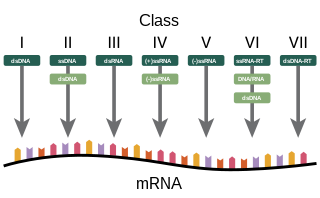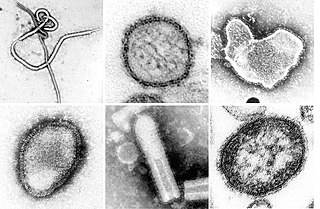
An RNA virus is a virus—other than a retrovirus—that has ribonucleic acid (RNA) as its genetic material. The nucleic acid is usually single-stranded RNA (ssRNA) but it may be double-stranded (dsRNA). Notable human diseases caused by RNA viruses include the common cold, influenza, SARS, MERS, Covid-19, Dengue Virus, hepatitis C, hepatitis E, West Nile fever, Ebola virus disease, rabies, polio, mumps, and measles.

Bunyavirales is an order of segmented negative-strand RNA viruses with mainly tripartite genomes. Member viruses infect arthropods, plants, protozoans, and vertebrates. It is the only order in the class Ellioviricetes. The name Bunyavirales derives from Bunyamwera, where the original type species Bunyamwera orthobunyavirus was first discovered. Ellioviricetes is named in honor of late virologist Richard M. Elliott for his early work on bunyaviruses.

Hepacivirus is a genus of positive-strand RNA viruses in the family Flaviviridae. The hepatitis C virus (HCV), in species Hepacivirus C, infects humans and is associated with hepatitis and hepatocellular carcinoma. There are fourteen species in the genus which infect a range of other vertebrate.

Baltimore classification is a system used to classify viruses based on their manner of messenger RNA (mRNA) synthesis. By organizing viruses based on their manner of mRNA production, it is possible to study viruses that behave similarly as a distinct group. Seven Baltimore groups are described that take into consideration whether the viral genome is made of deoxyribonucleic acid (DNA) or ribonucleic acid (RNA), whether the genome is single- or double-stranded, and whether the sense of a single-stranded RNA genome is positive or negative.
Varicosavirus is a genus of plant viruses. The virus is associated with swelling in plant vein tissues. They are negative single stranded RNA viruses. The genus contains three species.

Aspiviridae, formerly Ophioviridae, is a family of segmented negative-strand RNA viruses which infect plants. Member viruses are characterized by an elongated and highly filamentous and flexible nucleocapsid with helical symmetry. It is a monotypic taxon containing only one genus, Ophiovirus. Aspiviridae is also the only family in the order Serpentovirales, which in turn is the only order in the class Milneviricetes.

Nyavirus is a genus of negative-strand RNA viruses in the family Nyamiviridae. Ticks and birds serve as natural hosts. There are four species in this genus.

Quaranjavirus is a genus of enveloped RNA viruses, one of seven genera in the virus family Orthomyxoviridae. The genome is single-stranded, negative-sense segmented RNA, generally with six segments. The genus contains two species: Johnston Atoll virus and Quaranfil virus; it has been proposed to contain species or strains including Cygnet River virus, Lake Chad virus, Tyulek virus and Wellfleet Bay virus. Quaranjaviruses predominantly infect arthropods and birds; As of March 2015, Quaranfil quaranjavirus is the only member of the genus to have been shown to infect humans. The Quaranfil and Johnston Atoll viruses are transmitted between vertebrates by ticks, resembling members of Thogotovirus, another genus of Orthomyxoviridae.
Narnavirus is a genus of positive-strand RNA viruses in the family Narnaviridae. Fungi serve as natural hosts. There are two species in this genus. Member viruses have been shown to be required for sexual reproduction of Rhizopus microsporus. Narnaviruses have a naked RNA genome without a virion and derive their name from this feature.

Nyamiviridae is a family of negative-strand RNA viruses in the order Mononegavirales. Ecdysozoa and birds serve as natural hosts. The name is a portmanteau of Nyamanini Pan and Midway Atoll and the suffix -viridae used to denote a virus family. There are seven genera in this family.

Phenuiviridae is a family of negative-strand RNA viruses in the order Bunyavirales. Ruminants, camels, humans, and mosquitoes serve as natural hosts. Member genus Phlebovirus is the only genus of the family that has viruses that cause disease in humans except Dabie bandavirus.

Negative-strand RNA viruses are a group of related viruses that have negative-sense, single-stranded genomes made of ribonucleic acid. They have genomes that act as complementary strands from which messenger RNA (mRNA) is synthesized by the viral enzyme RNA-dependent RNA polymerase (RdRp). During replication of the viral genome, RdRp synthesizes a positive-sense antigenome that it uses as a template to create genomic negative-sense RNA. Negative-strand RNA viruses also share a number of other characteristics: most contain a viral envelope that surrounds the capsid, which encases the viral genome, −ssRNA virus genomes are usually linear, and it is common for their genome to be segmented.
Yuyuevirus is a genus of negative-strand RNA viruses which infect invertebrates. Member viruses have bisegmented genomes. It is the only genus in the family Yueviridae, which in turn is the only family in the order Goujianvirales and class Yunchangviricetes. Two species are recognized: Beihai yuyuevirus and Shahe yuyuevirus.

Articulavirales is an order of segmented negative-strand RNA viruses which infect invertebrates and vertebrates. It includes the family of influenza viruses which infect humans. It is the only order of viruses in the monotypic class Insthoviricetes. The order contains two families and eight genera.
Yingvirus is a genus of negative-strand RNA viruses which infect invertebrates. Member viruses have bisegmented genomes. It is the only genus in the family Qinviridae, which is the only family in Muvirales, which is the only order in Chunqiuviricetes. There are eight species in the genus.

Monjiviricetes is a class of negative-strand RNA viruses which infect fungi, plants, invertebrates, and vertebrates. The name is a portmanteau of the two orders within the class, Mononegavirales and Jingchuvirales and the suffix for a virus class -viricetes.
Alphamononivirus is a genus of enveloped, positive-strand RNA viruses in the order Nidovirales which infect planarian flatworms. Member virus planarian secretory cell nidovirus (PSCNV) has the largest known nonsegmented RNA genome of 41.1kb of any RNA virus. The genus is monotypic. It contains the subgenus Dumedivirus, which contains only one species, Planidovirus 1. Alphamononivirus is also the only member of the subfamily Mononivirinae, which in turn is the only member of family Mononiviridae, which likewise is the only member of the Monidovirineae suborder.
Yokose virus (YOKV) is in the genus Flavivirus of the family Flaviviridae. Flaviviridae are often found in arthropods, such as mosquitoes and ticks, and may also infect humans. The genus Flavivirus includes over 50 known viruses, including Yellow Fever, West Nile Virus, Zika Virus, and Japanese Encephalitis. Yokose virus is a new member of the Flavivirus family that has only been identified in a few bat species. Bats have been associated with several emerging zoonotic diseases such as Ebola and SARS.

Artoviridae is a family of negative-strand RNA viruses in the order Mononegavirales. Barnacles, copepods, odonates, parasitoid wasps, pile worms, and woodlice serve as natural hosts. The group name derives from arthropod the phylum of its hosts. Members of the family were initially discovered by high throughput sequencing.

Botourmiaviridae is a family of positive-strand RNA viruses which infect plants and fungi. The family includes four genera: Ourmiavirus, Botoulivirus, Magoulivirus and Scleroulivirus. Members of genus Ourmiavirus infect plants and the other genera infect fungi. The member viruses have genomes which range from 2900 to 4800 nucleotides.














